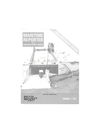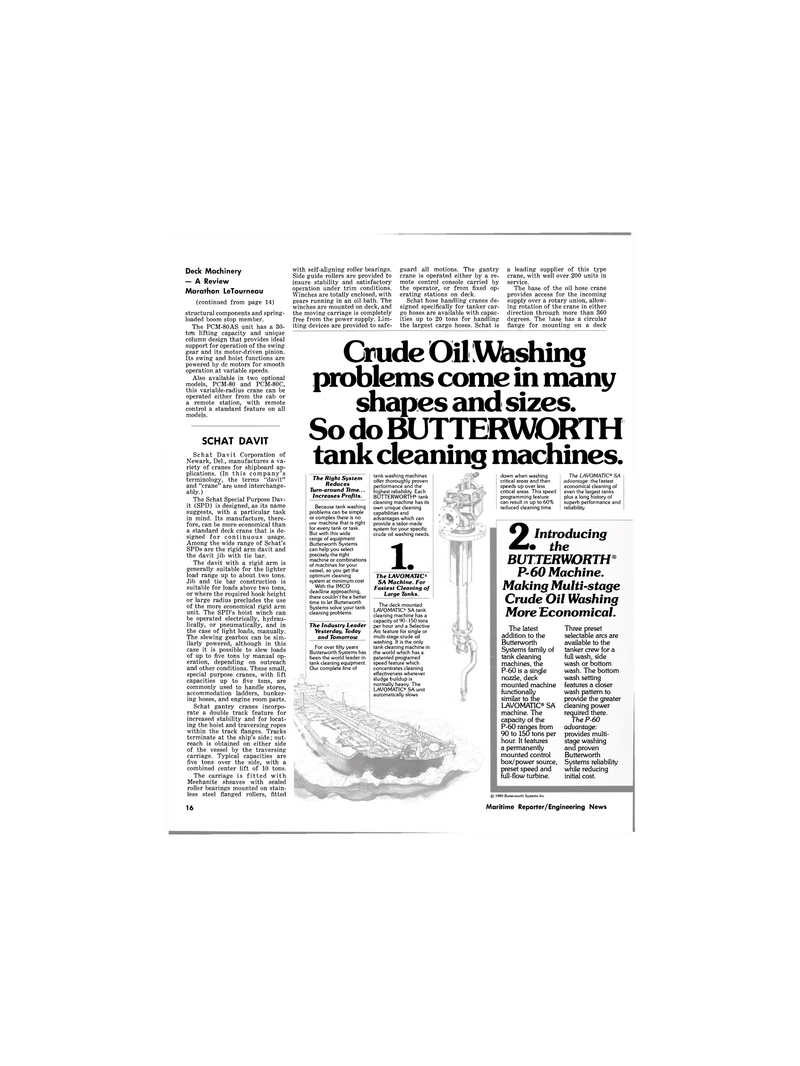
Page 14: of Maritime Reporter Magazine (February 1981)
Read this page in Pdf, Flash or Html5 edition of February 1981 Maritime Reporter Magazine
Deck Machinery — A Review
Marathon LeTourneau (continued from page 14) structural components and spring- loaded boom stop member.
The PCM-80AS unit has a 30- ton lifting capacity and unique cdlumn design that provides ideal support for operation of the swing gear and its motor-driven pinion.
Its swing and hoist functions are powered by dc motors for smooth operation at variable speeds.
Also available in two optional models, PCM-80 and PCM-80C, this variable-radius crane can be operated either from the cab or a remote station, with remote control a standard feature on all models.
SCHAT DAVIT
Schat Davit Corporation of
Newark, Del., manufactures a va- riety of cranes for shipboard ap- plications. (In this company's terminology, the terms "davit" and "crane" are used interchange- ably.)
The Schat Special Purpose Dav- it (SPD) is designed, as its name suggests, with a particular task in mind. Its manufacture, there- fore, can be more economical than a standard deck crane that is de- signed for continuous usage.
Among the wide range of Schat's
SPDs are the rigid arm davit and the davit jib with tie bar.
The davit with a rigid arm is generally suitable for the lighter load range up to about two tons.
Jib and tie bar construction is suitable for loads above two tons, or where the required hook height or large radius precludes the use of the more economical rigid arm unit. The SPD's hoist winch can be operated electrically, hydrau- lically, or pneumatically, and in the case of light loads, manually.
The slewing gearbox can be sim- ilarly powered, although in this case it is possible to slew loads of up to five tons by manual op- eration, depending on outreach and other conditions. These small, special purpose cranes, with lift capacities up to five tons, are commonly used to handle stores, accommodation ladders, bunker- ing hoses, and engine room parts.
Schat gantry cranes incorpo- rate a double track feature for increased stability and for locat- ing the hoist and traversing ropes within the track flanges. Tracks terminate at the ship's side; out- reach is obtained on either side of the vessel by the traversing carriage. Typical capacities are five tons over the side, with a combined center lift of 10 tons.
The carriage is fitted with
Meehanite sheaves with sealed roller bearings mounted on stain- less steel flanged rollers, fitted 16 with self-aligning roller bearings.
Side guide rollers are provided to insure stability and satisfactory operation under trim conditions.
Winches are totally enclosed, with gears running in an oil bath. The winches are mounted on deck, and the moving carriage is completely free from the power supply. Lim- iting devices are provided to safe- guard all motions. The gantry crane is operated either by a re- mote control console carried by the operator, or from fixed op- erating stations on deck.
Schat hose handling cranes de- signed specifically for tanker car- go hoses are available with capac- ities up to 20 tons for handling the largest cargo hoses. Schat is a leading supplier of this type crane, with well over 200 units in service.
The base of the oil hose crane provides access for the incoming supply over a rotary union, allow- ing rotation of the crane in either direction through more than 360 degrees. The base has a circular flange for mounting on a deck
Crude Oil Washing problems come in many shapes and sizes.
So do BUTTERWORTH tank cleaning machines.
The Right System
Reduces
Turn-around Time...
Increases Profits.
Because tank washing problems can be simple or complex there is no one machine that is right for every tank or task.
But with this wide range of equipment
Butterworth Systems can help you select precisely the right machine or combinations of machines for your vessel, so you get the optimum cleaning system at minimum cost.
With the IMCO deadline approaching, there couldn't be a better time to let Butterworth
Systems solve your tank cleaning problems.
The Industry Leader
Yesterday, Today and Tomorrow
For over fifty years
Butterworth Systems has been the world leader in tank cleaning equipment.
Our complete line of tank washing machines offer thoroughly proven performance and the highest reliability. Each
BUTTERWORTH11 tank cleaning machine has its own unique cleaning capabilities and advantages which can provide a tailor-made system for your specific crude oil washing needs. 1.
The LAVOMATIC «
SA Machine. For
Fastest Cleaning of
Large Tanks.
The deck mounted
LAVOMATIC* SA tank cleaning machine has a capacity of 90-150 tons per hour and a Selective
Arc feature for single or multi-stage crude oil washing. It is the only tank cleaning machine in the world which has a patented programed speed feature which concentrates cleaning effectiveness wherever sludge buildup is normally heavy. The
LAVOMATIC* SA unit automatically slows down when washing critical areas and then speeds up over less critical areas. This speed programming feature can result in up to 60% reduced cleaning time.
The LAVOMATIC® SA aduantage: the fastest economical cleaning of even the largest tanks plus a long history of superb performance and reliability. 2Introducing • the
BUTTERWORTH®
P- 60 Machine.
Making Multi-stage
Crude Oil Washing
More Economical.
The latest addition to the
Butterworth
Systems family of tank cleaning machines, the
P-60 is a single nozzle, deck mounted machine functionally similar to the
LAVOMATIC® SA machine. The capacity of the
P-60 ranges from 90 to 150 tons per hour. It features a permanently mounted control box/power source, preset speed and full-flow turbine. © 1980 Butterworth Systems Inc
Three preset selectable arcs are available to the tanker crew for a full wash, side wash or bottom wash. The bottom wash setting features a closer wash pattern to provide the greater cleaning power required there.
The P-60 aduantage: provides multi- stage washing and proven
Butterworth
Systems reliability while reducing initial cost.
Maritime Reporter/Engineering News

 13
13

 15
15
